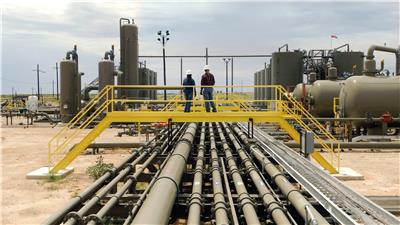
ALBUQUERQUE, N.M. — Exxon Mobil says it has a plan for cutting greenhouse gas emissions from its operations in one of the most prolific oilfields in the United States, saying it hopes to achieve its net-zero goal for operations in the Permian Basin by 2030.
The company made the announcement Monday, saying the effort will target both its own operations as well as indirect emissions associated with the electricity it buys to power well sites and other infrastructure in the basin, which spans parts of southeastern New Mexico and West Texas.
Although limited, Exxon’s announcement is significant because it’s the first tangible commitment the company has made to reducing greenhouse gas emissions, compared to major European oil and gas companies which set more tangible targets, said Artem Abramov, head of shale research at Rystad Energy.
“In the past, they were somewhat criticized for the lack of any sort of tangible commitment,” Abramov said.
The reach of Exxon’s commitment is narrow in several ways. For one, the goal is limited to its operations in a basin that represents about 12-13% of its total oil and gas production this year, Abramov said.
Exxon’s commitment does not addresses what are called “Scope 3” emissions, the largest category, which include the emissions produced when customers burn its oil or gas. The only way Exxon could reduce those emissions would be to cut back on how much oil and gas the company produces.
However, rather than reducing, Exxon’s production in the Permian Basin has been growing.
Exxon’s announcement dovetails with what is required of oil and gas companies operating in New Mexico under rules adopted by state regulators earlier this year. That includes better detection of methane emissions, upgrading equipment and eliminating routine flaring, which is the practice of burning off unwanted natural gas into atmosphere.
Touted by state officials as some of the strongest gas capture requirements in the nation, New Mexico’s rules set a target of capturing 98% of all natural gas waste by the end of 2026.
The U.S. Environmental Protection Agency also is poised to tighten federal methane regulations for the industry, and the New Mexico Environment Department is crafting its own rules aimed at oilfield equipment that emits methane, volatile organic compounds and nitrogen oxides.
The U.S. House Science Committee also has notified chief executives of Exxon and nine major oil companies that they must disclose more data about their methane emissions in the Permian Basin.
Rep. Eddie Bernice Johnson, a Texas Democrat who chairs the panel, said the companies’ current approach to monitoring methane emissions in the basin is inadequate. She said U.S. companies must do more to meet a recent pledge by the U.S. and more than 100 other countries to cut methane emissions by 30% by the end of the decade.
Besides Exxon, companies receiving the letter included Occidental Petroleum, ConocoPhillips, Chevron, Devon Energy and Pioneer Natural Resources.
Johnson said she was concerned that leak-detection and repair programs conducted by the oil industry may not identify intermittent leaks that contribute to climate pollution.
The committee set a Jan. 21 deadline for companies to provide data on methane leaks and detection efforts.
House Democrats have approved a plan to impose a fee on methane leaks from oil and gas wells, but the plan faces strong opposition from the industry and criticism by centrist Democrats as it moves to the Senate.
Exxon has made progress with reducing flaring in the Permian Basin. In 2018, Exxon was flaring 11.3% of its gas in the basin. The company brought that down 0.28% in the third quarter of 2021.
Earlier this month, Exxon said it would boost its spending on greenhouse gas emission-reduction projects to $15 billion over the next six years. The energy giant has been under pressure to reduce climate-harming emissions and investors forced turnover on the company’s board in June.
Major European oil and gas companies such as Shell and BP have been diversifying to invest more in solar and wind energy, but “when it comes to Exxon Mobil, they are not necessarily that proactive when it comes to renewable energy,” Abramov said. “They are investing in solar and wind to generate power for their oil and gas extraction. It’s not something they see as a future contributor to their revenue stream.”



